As the complexity of IT operations grows in businesses because of changing industry dynamism, the need for AIOps is increasingly being realized and emphasized upon. AIOps is increasingly going mainstream to improve IT efficiencies and supporting a faster decision-making process.
This blog will introduce readers to the concept of AIOps, followed by its applications in real-time business scenarios; Thus, enabling the readers to understand the importance of the new business operation trend and how to get started with the implementation of the same.
What is AIOps?
In the year 2019, IDC had predicted that expenditures on AI solutions are likely to increase to $97.9 billion by 2023. Post the COVID-19, the estimates meet staggering heights. This is where the importance of AIOps gets emphasized.
Simply put, AIOps is the application of artificial intelligence to IT operations. Basically, it uses the fundamentals of algorithmic analysis of IT data helping ITOps and DevOps teams to detect digital service issues earlier and resolve them quickly before a slack in operations starts impacting customers and businesses.
The diagram given below can help determine how AIOps has been helping businesses detect anomalies early.

Image source: Gartner
How does AIOps work?
The best part about AIOps is that it does not replace existing monitoring systems, algorithms, log management, service desk, and orchestration tools. Instead of that, it sits at the intersection of different domains and analyzes information and data across all of them. This helps in providing useful output to ensure a synchronized picture available from every tool.
It is noteworthy here that hardcoded integration logic struggles to keep pace with the changing dynamics of the IT environment. AIOps makes the process simpler and flexible by assembling partial views from various intersections and formats and sends a comprehensive understanding of the data churned to the IT team.
As projected in the diagram above, AIOps has three different stages:
Performance Analysis or Observe: This comprises two main tasks- the first is the processing of data from the legacy systems and detecting anomalies if any. The second task involves clustering the anomalies- algorithmic filtering that prevents alert fatigue and reduces the workload of IT operations as they do not have to work on similar work.
Experience Management or Engage: Once an anomaly is detected, systems installed with AIOps are in a position to alert the IT team about the anomalies before there’s a negative business impact. And, since these anomalies are already clustered, AIOps tools reduce alert fatigue.
Delivery Automation or Act: AIOps constantly learns from IT teams’ actions and automatically investigates and resolves issues before they reach the end-users or before even businesses are aware of them.
AIOps as an AI solution: Key Benefits
The following paragraphs detail the way AIOps is changing the way businesses function. For instance,
Supporting DevOps practices
DevOps tops the list of needed skills by businesses. In a business setting, AI can automatically optimize codes for performance. For instance, AI can discover patterns that imply inefficient use of infrastructure resources and even make automatic quick fixes. This can improve the DevOps integration cycles greatly.
AI solutions for understanding customer requirements
The idea is to stay ahead in the competition to understand what customers are looking for before your competitors and even before the clients themselves. This helps IT businesses to pitch their products the right way at the right time. Implementing alert correlation for adopting more business-friendly metrics and mapping IT metrics for specific business services are some of the other benefits of assigning AI to IT. AIOps has the capacity to track key performance indicators by analyzing information metrics.
AIOps used on network edge saves time and money
Implementing AIOps on the edge of the network empowers AI-enabled monitoring cost-effectively and within a fraction of the time. Operating from clouds will eliminate the travel time from the data center to the cloud service and back. Faster resolution of incidences reduces the time and the capital required for business operations. Since the deployment of AIOps happens from the cloud, businesses are safe.
Easy data ingestion and correlation
AIOps can address routine problems automatically while correlating data from multiple cloud providers, hybrid environments, and edge devices. This not only helps in improving the operations faster but also reduces the time for customer churning by optimizing digital experience across customer-facing technologies.
Cybersecurity with AIOps
Companies like IBM and Splunk are projecting huge movement toward adopting AIOps to enhance the security of data processing, analysis, and storage. This is because AIOps is said to resolve 86% of security-related issues without human interference, thus reducing the resolution time by 65%.
AI and IoT make the best pair
The confluence between IoT and AIOps is fast catching up the pace because of their individual characteristics. With AI’s prevalence of sensors and quick resolution capabilities to provide actionable insights. Coupled with IoT’s capabilities of monitoring and storing data, systems installed with AIOpscan take action on the data it monitors, reducing costs and increasing the overall revenues. While this will have a definite impact on smart commercial spaces, the confluence will enable the unique application of data to enhance security, improve sustainability practices, and real-time offer optimization.
AI in Marketing
Marketing can show splendid use cases of AI because the latter depends on data analysis heavily. With the incorporation of AIOps in systems, target-based marketing can be taken a step further. The more the data, the better is the performance of AIOps-enabled systems because systems gain the capacity of identifying crucial patterns and offer best-in-class targeted outcomes.
AIOps, ITOps, CloudOps, DevOps, and NoOps: Which is better?
It takes a lot of factors to decide which ‘Ops’ are best for a business. Some of them being business goals, requirements, budget, and scope of implementation. However, we will highlight the key elements of each of the Ops for you to decide for yourself.
| ITOps | CloudOps | DevOps | NoOps | BizDevOps | AIOps | |
| Goals | It fulfills the basic requirements of IT operations such as delivering, maintenance of applications and technologies | A step ahead of ITOps as organizations optimize use cloud solutions or hybrid clouds to optimize their resources | Combination of R&D, QA, and ITOps, the main goal is to automate as many tasks as possible. | Reduce or nullify the requirement of DevOps operators and completely automating the systems | It typically helps businesses following agile methodology that aim to respond to market needs quickly. Simply put, it is a notch ahead of DevOps directing DevOps teams to build responsive businesses. It is also referred to as a DevOps 2.0. | To provide organizations with data from multiple sources for analytics and automation. |
| Features | Administration and management
Network management System management Technical support |
Cloud-specific scalability of environments built-in task automation | Less integration time
Reduced operation time and cost\Faster software development Improved team collaboration Early defect detection Faster correction |
Minimal to nil human error
Encourages IT advancements DevOps accelerates daily operations and collaborations |
Agility accelerates the development pace
Business-centric It requires additional user experience analytics solutions |
Fast time to market
Quick recovery Processed data for decision-making Structuring data from different feeds |
| Use Cases | Adopted in every small and big organization at some level | Configuration management, resource allocation, cloud management, optimizing performance capacity, managing compliance burden, SLA compliance. | Network cycling, car manufacturing, finance and trading, airline industries | Scalability and high availability
No idle time costs Cloud security |
Across industries and verticals in an organization | Across industries and organization verticals |
| Effectiveness | They are ineffective from a development point of view because of businesses’ present-day complex demand and pace. | It is effective only within the realm of computing resource management and since their specialization is extremely narrow in terms of modern-day Ops requirements. | It shortens the software development life cycle and improves responsiveness to market needs, thus shortening the time to market. However, it requires strong interdepartmental communication, which may be impractical in real-life business scenarios. | Only effective in large organizations with matured operating systems. Involves a lot of investment plus a level of lack of control over serverless systems used for the purpose. | Highly effective with diversified toolsets | Highly effective with matured companies and other organizations with the budget and the bandwidth to incorporate AIOps. Improves problem-solving capabilities and human intervention. |
Whatever you adopt, depends on the intensity of the scaling up you are ready to do to your existing systems and the budget you have for the purpose. Can’t decide for yourself which of the above-mentioned Ops suits you best? Speak to software providers and consultants like aQb Solutions to help you decide and design AIOps software for you.
aQb Solutions has a consultation and software development legacy of over 10 years. With a vibrant team of experts, it has worked with some of the top-notch companies in India and the United States, following a strict 5D methodology to identify their requirements, offer them relevant IT consultation, followed by software development.
An ISO 270001: 2013 certified company, aQb Solutions has proved its excellence in software engineering time and again with secured robust and business-centric solutions.
So, what are you waiting for? Consult us now for your next IT requirement.




